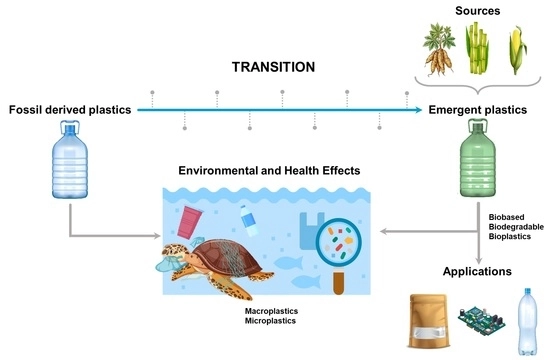Plastics have become an essential part of the modern world thanks to their appealing physical and chemical properties as well as their low production cost. The most common type of polymers used for plastic account for 90% of the total production and are made from petroleum-based nonrenewable resources. Concerns over the sustainability of the current production model and the environmental implications of traditional plastics have fueled the demand for greener formulations and alternatives. In the last decade, new plastics manufactured from renewable sources and biological processes have emerged from research and have been established as a commercially viable solution with less adverse effects. Nevertheless, economic and legislative challenges for biobased plastics hinder their widespread implementation. This review summarizes the history of plastics over the last century, including the most relevant bioplastics and production methods, the environmental impact and mitigation of the adverse effects of conventional and emerging plastics, and the regulatory landscape that renewable and recyclable bioplastics face to reach a sustainable future (Melchor-Martínez et al., 2022).

Personal notes:
It is necessary to understand the behavior of synthetic polymers and those of natural origin to have the criterion to choose and propose alternatives. Selecting a material for any project or product involves knowing each material’s physical, chemical, and mechanical characteristics. Therefore, this class of articles facilitates the acquisition of knowledge about those characteristics. When entering the material world, it is necessary to leave aside the background and be willing to learn from different areas of expertise. In the end, all this is done with the idea of implementing what has been discovered in your expertise area, in this case, to be able to apply it in design. It is still developing biopolymers alternatives that are ecologically and economically viable because challenges have been identified in the implementation, production, and recycling of the biopolymers that have been created.
Melchor-Martínez, E. M., Macías-Garbett, R., Alvarado-Ramírez, L., Araújo, R. G., Sosa-Hernández, J. E., Ramírez-Gamboa, D., Parra-Arroyo, L., Alvarez, A. G., Monteverde, R. P., Cazares, K. A., Reyes-Mayer, A., Yáñez Lino, M., Iqbal, H. M., & Parra-Saldívar, R. (2022). Towards a circular economy of plastics: An evaluation of the systematic transition to a new generation of bioplastics. Polymers, 14(6), 1203. https://doi.org/10.3390/polym14061203




